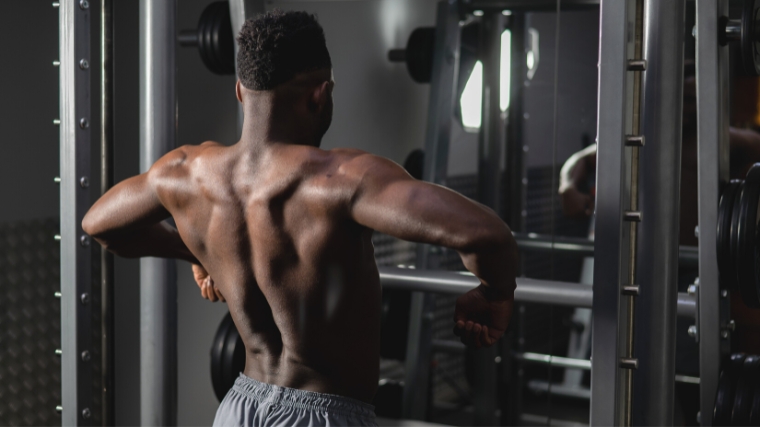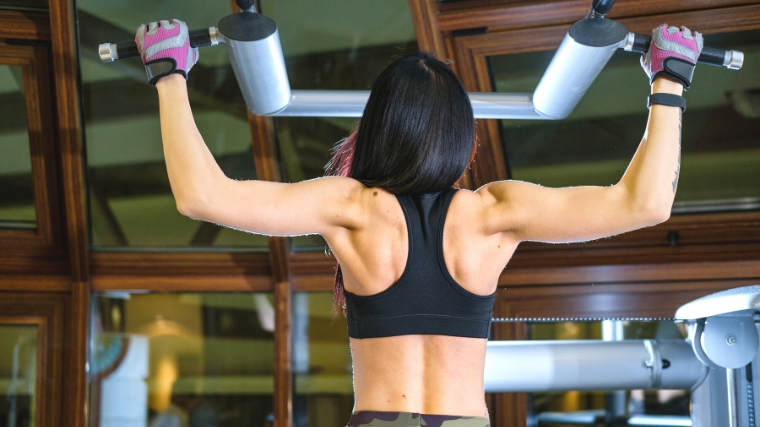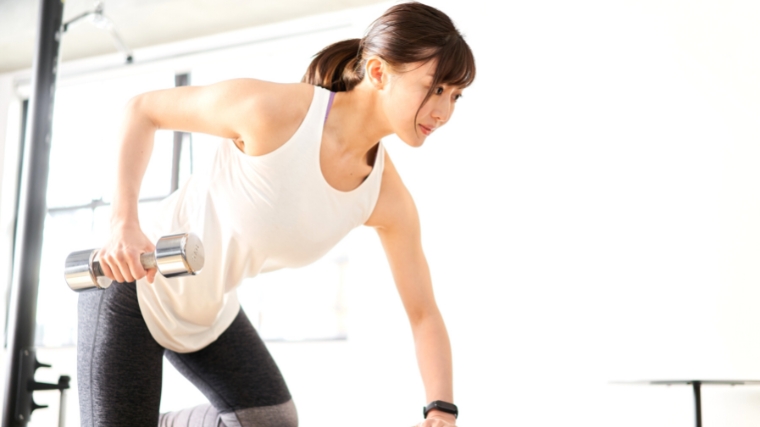The 9 Best Scapular Exercises (2024 Update) | BarBend (original) (raw)
When you’re training, your mind is usually occupied with muscles, muscles, and more muscles. And yes, you want your muscles to get bigger and stronger. But your muscles act on your bones and joints.
And the scapulae — AKA, your shoulder blades — are two of those bones. Your shoulder blades need to rotate and move at the right time, in the right direction, to allow for smooth upper-body movements. This harmony allows you to pull, press, and throw without discomfort.

Credit: Reshetnikov_art / Shutterstock
Here, you’ll find the best scapular exercises to mobilize your shoulder joints and strengthen the muscles that attach to your shoulder blades. With these moves, you can improve shoulder mobility, reduce injury risk, and build a very strong upper body.
Best Scapular Exercises
- Roll, Pin, and Stretch
- Stability Bent-Over Dumbbell Rear Delt Raise
- Face Pull
- Reach and Row
- Push-Up Plus
- Band YTWL
- Stability Ball Push-Up
- Bottoms-Up Overhead Kettlebell Carry
- Mini-Band Wall Slide
Editor’s Note: The content on BarBend is meant to be informative in nature, but it should not be taken as medical advice. When starting a new training regimen and/or diet, it is always a good idea to consult with a trusted medical professional. We are not a medical resource. The opinions and articles on this site are not intended for use as diagnosis, prevention, and/or treatment of health problems. They are not substitutes for consulting a qualified medical professional.
Roll, Pin, and Stretch
Your shoulder blades aren’t all about your shoulders. The pec minor — a chest muscle underneath the clavicle — can get tight due to rounded shoulders after long hours at your computer.
Opening this muscle up with some self-myofascial release can help significantly with improving your posture and shoulder mobility. With these improvements, you’ll be in a better position to increase the strength of your shoulders and chest alike.
Benefits of the Roll, Pin, and Stretch
- When raising your arm overhead, this exercise trains you to fully utilize your rotator muscles.
- This massage can help improve posture and shoulder mobility, which may help reduce shoulder injuries.
- This form of exercise can help improve your ability to breathe through discomfort, which can be an advantage when you’re progressively overloading your lifts.
How to Do the Roll, Pin, and Stretch
Place the lacrosse ball between your chest and clavicle against a wall. Press hard into the wall by leaning your hips forward. Massage the ball over a one to two inch area. Avoid rolling the ball directly over your bones and joints. After a minute, push hard into the wall and raise your arm laterally, spreading your fingers apart until you feel a slight stretch. Go up and down ten times.
Stability Bent-Over Dumbbell Rear Delt Raise
The bent-over rear delt raise is also known as the reverse fly. This exercise adds volume to your posterior deltoid training.
With this move, you work your often-overlooked rhomboids and the middle traps. When you perform a unilateral version of this move by holding the squat rack for balance, you’ll combat muscle imbalances between sides for healthier scaps.
Benefits of the Stability Bent-Over Dumbbell Rear Delt Raise
- This exercise strengthens your rear deltoids and the muscles between the scapula of the upper back.
- It directly targets smaller muscles because you’re not using your lats and biceps to initiate the movement.
- Since you’re strengthening each side unilaterally, you’ll fight off imbalances between sides.
How to Do the Stability Bent-Over Dumbbell Rear Delt Raise
Stand beside a squat rack and grab hold of it at or below chest height. With a dumbbell in your opposite hand, hinge at your hips. Keep your shoulders down and your chest up. With a soft bend in your working elbow, use your upper back and shoulders to bring the dumbbell out and up along your side. Slowly lower down to the starting position. Reset and repeat.
Face Pull
The face pull will strengthen the muscles around your scapulae and help add muscle and strength to this vital region. Here, you’ll be strengthening two primary functions of the scapulae: abduction (eccentrically) and adduction (concentrically).
Performing an external rotation at the end of each exercise will help pull your shoulders back into better position. This can create improved posture and reduce shoulder injury risk.
Benefits of the Face Pull
- The face pull increases shoulder strength, improves scapular movement, and strengthens your external shoulder rotators.
- This exercise isolates the muscles between the scapulae, is easy to perform, and makes for an excellent warm-up or active recovery exercise.
- It helps to improve posture and the health of your entire shoulder region.
How to Do the Face Pull
Hold a cable machine rope attachment or resistance band with an overhand grip. Step back until your elbows are extended with some tension. Engage your core and glutes. With your shoulders down and chest up, pull the rope or band towards your face by squeezing your shoulder blades together. Hold this position for two seconds. Slowly return to the starting position. Reset and repeat.
Reach and Row
The reach and row is your standard single-arm row — with a slight twist. Performed with a cable or resistance band, you will initiate the movement by reaching’ forward, moving one shoulder blade away from the other.
The reach trains your serratus anterior, giving your upper back an active stretch. You’ll take the move through a bigger range of motion for more muscle-building potential.
Benefits of the Reach and Row
- The increased range of motion gives your upper back more time under tension and increased muscle-building potential.
- This exercise takes your scapulae through a fuller range of motion for better shoulder mobility.
- You’ll train the serratus anterior, an essential muscle for scapular abduction and shoulder health.
How to Do the Reach and Row
Walk back with the resistance band or cable in one hand. Set up in a split stance. Reach forward towards the anchor point, letting the resistance pull you slightly. Then pull the handle towards your hip while keeping your shoulder down. Stand up straight. Slowly lower back to the reach position. Reset and repeat.
Push-Up Plus
Push-ups are great for the scapula and the rest of your body, but there is one way to improve them. Many lifters finish push-ups by locking out their elbows, and that’s fine. But to enhance scapular movement and health, finish the push-up with a flare.
With the push-up plus, you’ll protract your shoulder blades by pushing further away from the floor. This ‘plus’ strengthens the serratus anterior, a muscle that attaches the scapula to the rib cage.
Benefits of the Push-Up Plus
- The push-up plus strengthens the serratus anterior, an essential muscle for shoulder health and performance.
- This move helps give the lifter that cut or serrated look underneath their chest if that’s a goal they have.
- The extra range of motion of the push-up plus provides more of a muscle-building stimulus to your chest and triceps.
How to Do the Push-Up Plus
Get into a regular push-up position with your hands underneath your shoulders and your body in a straight line from head to heel. Lower your chest until it almost touches the floor, then push up. Then push your hands through the floor, protracting your shoulder blades and rounding your upper back. Reset and repeat for desired reps.
Band YTWL
The beauty of using bands to perform the YTWL movement is the accommodating resistance of the band. The resistance band will maintain constant tension on your muscles, requiring a tremendous amount of endurance and strength.
This makes for a strong upper back and rotator cuffs while reinforcing the scapulae from multiple directions. Training the muscles surrounding the scapulae from these directions will help make your shoulder area more resilient.
Benefits of the Band YTWL
- The band YTWL improves scapular stability by strengthening your shoulders and upper back from multiple directions.
- This strengthens movements mimicked in daily activities or on the sporting field for reduced injury risk.
- The band YTWL can help improve posture and the position of your shoulders.
How to Do the Band YTWL
Anchor a light, looped resistance band at chest level. Step back and grab either side of the band until it’s tight. With your arms outstretched, raise your arms overhead in the shape of a Y for five reps, then a T for five reps, and then a W for five reps. Perform the L by keeping your elbows high as you pull the band towards you for five reps.
Stability Ball Push-Up
If regular push-ups are easy for you, kick it up a notch. Introducing the stability ball to push-ups increases the difficulty because you’re pressing on an uneven surface.
Here, you will focus on balance and strengthen your upper and lower body stabilizing muscles. Although your shoulder blades are made to move, they stabilize, too. This exercise tests and improves your scapular stability.
Benefits of the Stability Ball Push-Up
- The stability ball recruits more abdominal muscles to strengthen your core.
- The instability of the stability ball push-up strengthens the stabilizing muscles of the scapulae.
- This is an excellent exercise to add intensity to your push-ups without adding weight.
How to Do the Stability Ball Push-Up
Start in a push-up position with your hands centered on either side of the stability ball. Place your feet a bit wider than hip-width apart on the floor. The wider apart your feet, the easier it is; the narrower, the more difficult. Engage your core and glutes. Lower yourself down to the ball. Press back to the starting position. Reset and repeat.
Bottoms-Up Kettlebell Carry
All carries will improve your grip strength and shoulder stability. But holding kettlebell bottoms-up — with the bottom of the kettlebell facing the ceiling — takes this to the next level.
Bottoms-up kettlebell carries are performed with your arms overhead or in the semi-racked position. The overhead variation is more difficult because the load is farther from your center of gravity, making it harder to balance with every step. Both versions can improve your posture, lateral stability, and grip strength while boosting scapular stability.
Benefits of the Bottoms-Up Kettlebell Carry
- The unstable nature of holding a kettlebell bottoms-up increases your shoulder stability demands, helping strengthen your grip, rotator cuff, and scaps.
- This position will provide additional muscular tension, which gives you a big training stimulus with relatively light weights.
- The bottom-up kettlebell strengthens your fingers, wrists, and forearms, which helps improve all exercises requiring grip strength.
How to Do the Bottoms-Up Kettlebell Carry
Start with a light kettlebell — you don’t need much weight to get a training effect here. Grasp the handle in the middle with your wrist in a neutral, straight position. Lift the bell so that the bottom is facing the ceiling. With your arm in the semi-racked or overhead position, and with your shoulder down and chest up, walk for the required distance. Repeat on the other side.
Mini-Band Wall Slide
Wall slides on their own provide excellent stimuli for scapular stability. Performing the move with mini-bands takes wall slides to a new level.
The standard wall slide trains the scapular retractors, outward rotators, and lower traps. Adding the mini-band further strengthens your scapular outward rotators and retractors as your hands resist the mini-band pulling you in.
Benefits of the Mini-Band Wall Slide
- The mini-band wall slide improves shoulder mobility, the strength of your upper back muscles, and scapular stabilizers.
- This exercise helps to improve your overhead range of motion and position for a better overhead press.
- Mini-band wall slides are a versatile exercise that you can use for your warm-up or as active recovery between sets of any overhead strength exercise.
How to Do the Mini-Band Wall Slide
Place a light mini-band around your wrists. Stand with your back facing a wall, with your heels and/or glutes touching the wall. Press your lower back into the wall to avoid hyperextension. Place your forearms and elbows on the wall at shoulder height. While standing tall, slowly slide your forearms up the wall until your elbows are extended. Return to the starting position. Reset and repeat.
Programming Scapular Training
Your shoulder blades are involved with so many upper body muscles. As such, they’re involved with countless back, shoulder, and chest exercises. It’s easy to directly target the scapulae without adding too many exercises to your programming.

Credit: Pavel Korotkov / Shutterstock
[Read More: The Best Ab Exercises & Workouts, According to a CPT]
You can select two to three exercises from the list above and perform them as a part of your warm-up. Exercises like the mini-band wall slide for ten reps work well as a warm-up. You can also swap a typical upper-body pulling accessory with the reach and row or band YTWLs for an added boost of stability training.
For exercises where you can count reps, stick with two to four sets of 10 to 15 reps, except for the push-up plus, which you can perform to technical failure. The key is to form a powerful mind-muscle connection with the muscles that attach to the scapula. Lifting with control is the trick here.
Scapular Training Tips
Your shoulder blades are vital to the health and performance of your upper body. Although almost all major upper body movements train muscles that attach to your shoulder blades, it pays to keep these tips in mind when directly training the scapulae.
It’s Not All About Load
Progressive overload is the name of the game when it comes to gains. But there is a point where load can deteriorate form and your mind-muscle connection with the scaps. Ensure you feel your scaps, upper back, and shoulder muscles aren’t too overloaded when performing the above exercises.

Credit: mapo_japan / Shutterstock
**_[Read More: The_** Best Upper Body Exercises and Workouts]
When it’s time to increase the weight, do so gradually. Otherwise, progress your movements with tempo training and increased focus on form rather than adding weight.
Use Control
There is no need to hurry your exercises, especially here. Perform each exercise with control during the entire repetition. This results in more time under tension and lets you move through a full range of motion. Moving mindlessly through your repetitions will give you inferior results.
Use Full Range Of Motion
Generally speaking, if you want to make the most of your scapular training, you’ll want to take each rep through a full range of motion. This can mean retraction, protraction, and outward and inward rotation — or a combination of all of them — depending on the exercise. Move with control and allow yourself to fully breathe into each rep.
Healthy Scaps, Healthy Shoulders
Your shoulder blades play a vital role in the movement and strength of your upper body. Although most upper body exercises involve the scapulae to some degree, directly targeting your shoulder blades with scapular exercises will go a long way.
With moves like this, you’ll strengthen and stabilize the muscles attached to your shoulder blades to improve all your upper body movements. Subbing some of these nine shoulder blade exercises into your programming can strengthen your big lifts and keep your shoulders in tip-top shape.
Featured image: Monkey Business Images / Shutterstock